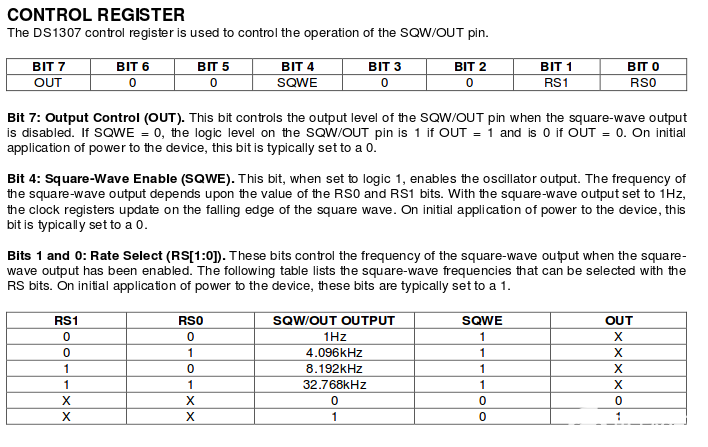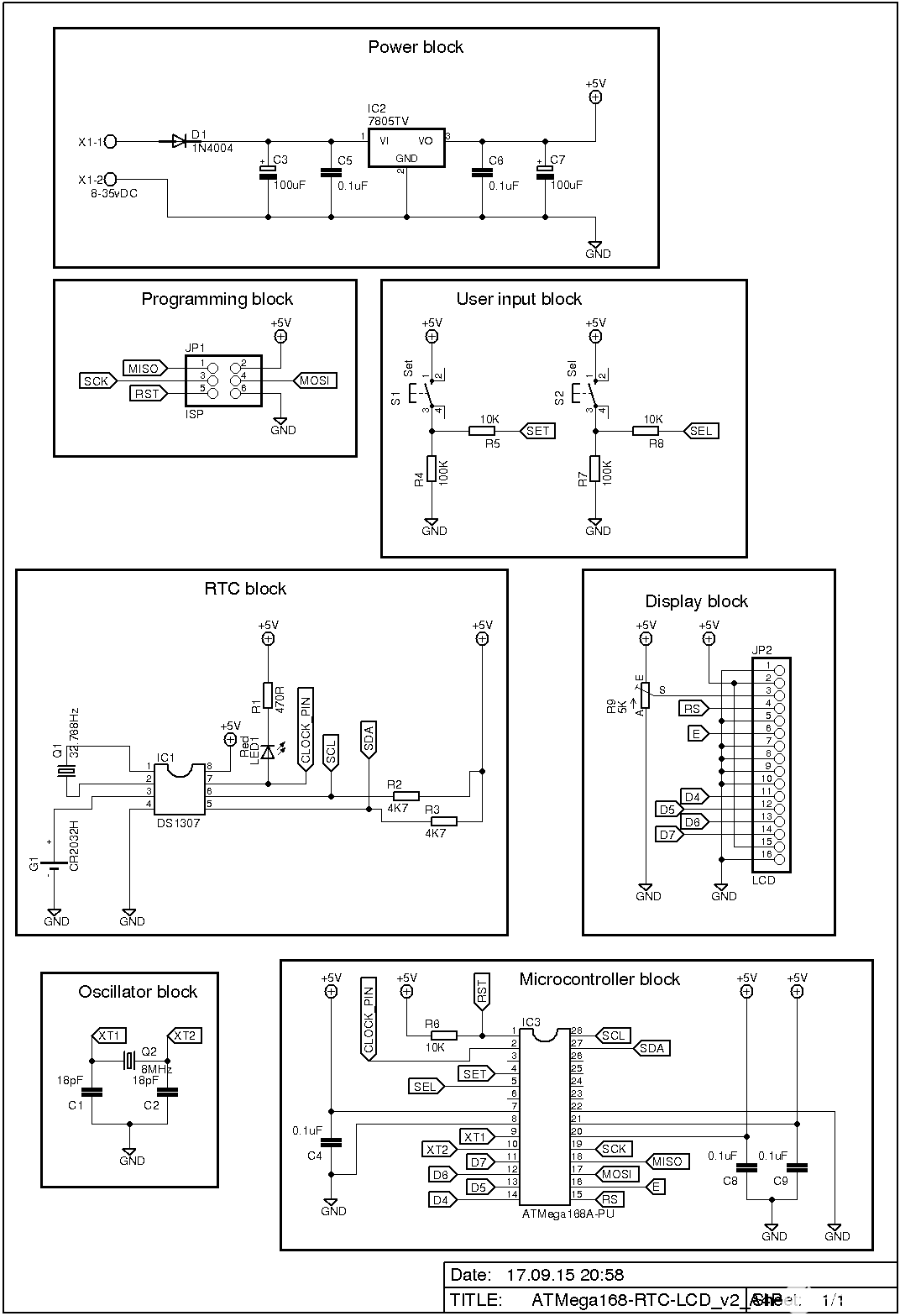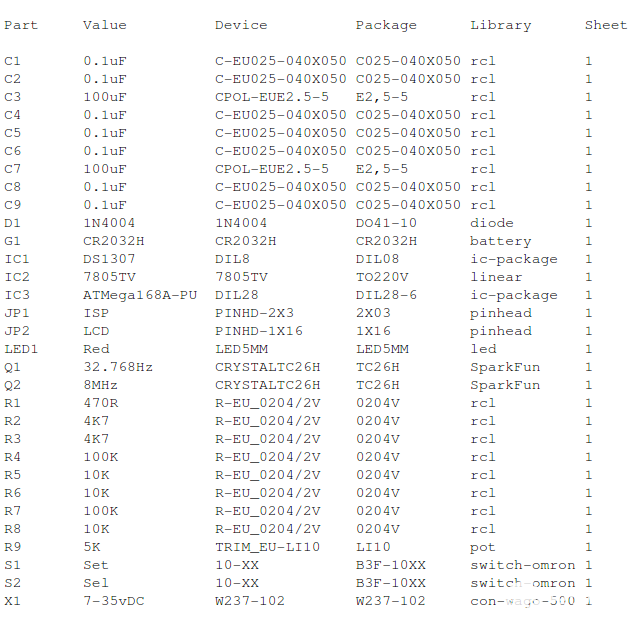

使用实时时钟IC DS1307制作精确时钟的方法
描述
如何使用实时时钟 IC DS1307 制作准确的时钟。时间将显示在液晶显示屏上。
要求
运行 Arduino 1.6.5 的计算机
阿杜诺
跳线
面包板
零件清单中的零件
您可以用 ATMEL 的另一个 IC 替换 Arduino,但要确保它具有足够数量的输入和输出引脚以及 I 2 C 功能。我正在使用 ATMega168A-PU。如果你这样做,你将需要一个程序员。我有 AVR MKII ISP 编程器。
建议读者熟悉面包板,在Arduino环境下编程,对C编程语言有一定的了解。下面的两个程序不需要额外的解释。
介绍
微控制器如何跟踪时间和日期?普通的微控制器有一个定时器功能,上电时从0(零)开始,然后开始计数。在 Arduino 世界中,我们可以使用 millis() 函数来重置自上电以来经过的毫秒数。当您断开并重新连接电源时,它会重新开始。这在时钟和日期方面不太方便。
这就是实时时钟或 RTC 芯片派上用场的地方。该 IC 带有 3v 纽扣电池或另一个 3v 电源,可跟踪时间和日期。时钟/日历提供秒、分钟、小时、星期、日期、月份和年份信息。IC 以 30/31 天和闰年校正月份。通过 I 2 C 总线进行通信。I 2 C 总线将不在这里讨论。
如果主电路的 Vcc 低于 Vbat,RTC 会自动切换到低功耗电池备份模式。备用电池通常是连接到 PIN 3 和 GND 的 3v 纽扣电池。通过这种方式,IC 仍会跟踪时间和日期,当主电路通电时,微控制器会获取当前时间和日期。
在这个项目中,我们使用的是DS1307。在该 IC 上,引脚 7 是 SQW/OUT 引脚。您可以使用此引脚来闪烁 LED,或为微控制器计时。我们将两者都做。数据表中的下图有助于我们了解 SQW/OUT。

此表可帮助您了解频率:
频率BIT7 & BIT6 & BIT5BIT4第 3 位和第 2 位BIT1位0
1赫兹 01 0 0 0
4.096Hz 01 0 0 1
8.192Hz 01 0 1 0
32.768Hz 01 0 1 1
如果将 LED 和电阻连接到 PIN 7,并希望它以 1Hz 频率闪烁,则将 0b00010000 写入控制寄存器内存地址。如果你想要 4.096 Hz,你会写 0b000100001。现在您需要一台示波器来查看脉冲,因为 LED 闪烁得如此之快,以至于看起来它一直亮着。我们使用的是 1Hz。
硬件
这是我们想要的框图。

我们想要:
ISP(在系统编程中)对微控制器进行编程
按钮设置时间和日期
微控制器通过 I 2 C与 RTC 通信
在 LCD 上显示时间和日期
示意图:

点击图片为全尺寸。
零件清单
这是 Eagle 的截图:

软件
我们将在本指南中使用两种不同的草图:一种将时间和日期写入 RTC,另一种从 RTC 读取时间和日期。我已经这样做了,因此您将对正在发生的事情有更好的了解。我们将为这两个程序使用与上述相同的电路。
首先,我们将时间和日期写入 RTC,这就像在手表上设置时间一样。
我们使用两个开关。一种是增加小时、分钟、日期、月、年和星期几,另一种是在它们之间进行选择。该应用程序不会从任何关键传感器读取值,因此我们使用中断来检查是否按下了开关并处理开关弹跳。有关开关弹跳的更多信息, 请阅读此。
以下代码将设置值并将它们写入 RTC:
// Include header files
#include
#include
// LCD pin definitions
#define RS 9
#define E 10
#define D4 8
#define D5 7
#define D6 6
#define D7 5
LiquidCrystal lcd(RS, E, D4, D5, D6, D7);
// Interrupt 0 is hardware pin 4 (digital pin 2)
int btnSet = 0;
// Interrupt 1 is hardware pin 5 (digital pin 3)
int btnSel = 1;
// Interrupt state
int togBtnSet = false;
int togBtnSel = false;
// Time and date variables
int tmpHour = 0;
int tmpMinute = 0;
int tmpDate = 0;
int tmpMonth = 0;
int tmpYear = 0;
int tmpDay = 0;
int tmpSecond = 0;
int counterVal = 0;
// Variable to keep track of where we are in the "menu"
int myMenu[6]; // 0=Hour, 1=Minutes, 2=date, 3=MOnth, 4=Year, 5=DOW
int menuCounter = 0;
// A array of the weekday
char* days[] = { "NA", "Mon", "Tue", "Wed", "Thu", "Fre", "Sat", "Sun" };
void setup() {
// Interrupt declaration, execute increaseValue/nextItem function
// when btnXXX is RISING
attachInterrupt(btnSet, increaseValue, RISING);
attachInterrupt(btnSel, nextItem, RISING);
Wire.begin();
lcd.begin(16,2);
showWelcome();
}
// Interrupt function
void increaseValue()
{
// Variables
static unsigned long lastInterruptTime = 0;
// Making a timestamp
unsigned long interruptTime = millis();
// If timestamp - lastInterruptTime is greater than 200
if (interruptTime - lastInterruptTime > 200)
{
// Toggle the variable
togBtnSet = !togBtnSet;
// Increase the counterVal by 1
counterVal++;
}
// Setting lastInterruptTime equal to the timestamp
// so we know we moved on
lastInterruptTime = interruptTime;
}
// Next menuItem Interrupt function
void nextItem()
{
static unsigned long lastInterruptTime = 0;
unsigned long interruptTime = millis();
if (interruptTime - lastInterruptTime > 200)
{
togBtnSel = !togBtnSel;
// Increase the menu counter so we move to next item
menuCounter++;
// Placing the counterVal in the menucounters array position
myMenu[menuCounter] = counterVal;
// Reset counterVal, now we start at 0 on the next menuItem
counterVal = 0;
}
lastInterruptTime = interruptTime;
}
// Function that convert decimal numbers to binary
byte decToBCD(byte val)
{
return ((val/10*16) + (val));
}
// Short welcome message, now we know everything is OK
void showWelcome()
{
lcd.setCursor(2,0);
lcd.print("Hello world.");
lcd.setCursor(3,1);
lcd.print("I'm alive.");
delay(500);
lcd.clear();
}
// Funcion to set the hour
void setHour()
{
lcd.setCursor(0,0);
lcd.print("Set hour. ");
// Checks if interrupt has occured = button pressed
if (togBtnSet)
{
// Update array value with counterVal
myMenu[menuCounter] = counterVal;
lcd.setCursor(7,1);
// Print the new value
lcd.print(myMenu[menuCounter]); lcd.print(" ");
}
else
{
// Update array value with counterVal
myMenu[menuCounter] = counterVal;
lcd.setCursor(7,1);
// Print the new value
lcd.print(myMenu[menuCounter]); lcd.print(" ");
}
}
// Function to set minutes
void setMinute()
{
lcd.setCursor(0,0);
lcd.print("Set minute. ");
if (togBtnSet)
{
myMenu[menuCounter] = counterVal;
lcd.setCursor(7,1);
lcd.print(myMenu[menuCounter]); lcd.print(" ");
}
else
{
myMenu[menuCounter] = counterVal;
lcd.setCursor(7,1);
lcd.print(myMenu[menuCounter]); lcd.print(" ");
}
}
// Function to set date
void setDate()
{
lcd.setCursor(0,0);
lcd.print("Set date. ");
if (togBtnSet)
{
myMenu[menuCounter] = counterVal;
lcd.setCursor(7,1);
lcd.print(myMenu[menuCounter]); lcd.print(" ");
}
else
{
myMenu[menuCounter] = counterVal;
lcd.setCursor(7,1);
lcd.print(myMenu[menuCounter]); lcd.print(" ");
}
}
// Function to set month
void setMonth()
{
lcd.setCursor(0,0);
lcd.print("Set month. ");
if (togBtnSet)
{
myMenu[menuCounter] = counterVal;
lcd.setCursor(7,1);
lcd.print(myMenu[menuCounter]); lcd.print(" ");
}
else
{
myMenu[menuCounter] = counterVal;
lcd.setCursor(7,1);
lcd.print(myMenu[menuCounter]); lcd.print(" ");
}
}
// Function to set year
void setYear()
{
lcd.setCursor(0,0);
lcd.print("Set year. ");
if (togBtnSet)
{
myMenu[menuCounter] = counterVal;
lcd.setCursor(7,1);
lcd.print(myMenu[menuCounter]); lcd.print(" ");
}
else
{
myMenu[menuCounter] = counterVal;
lcd.setCursor(7,1);
lcd.print(myMenu[menuCounter]); lcd.print(" ");
}
}
// Function to set the day of week
void setDOW()
{
lcd.setCursor(0,0);
lcd.print("Set day (1=mon).");
if (togBtnSet)
{
myMenu[menuCounter] = counterVal;
lcd.setCursor(7,1);
lcd.print(myMenu[menuCounter]); lcd.print(" ");
}
else
{
myMenu[menuCounter] = counterVal;
lcd.setCursor(7,1);
lcd.print(myMenu[menuCounter]); lcd.print(" ");
}
}
// Write the data to the RTC
void writeRTC()
{
Wire.beginTransmission(0x68);
Wire.write(0); // Start address
Wire.write(0x00); // seconds
Wire.write(decToBCD(myMenu[1])); // convert tmpMinutes to BCD and write them
Wire.write(decToBCD(myMenu[0])); // convert tmpHour to BCD and write them
Wire.write(decToBCD(myMenu[5])); // convert tmpDay to BCD and write them
Wire.write(decToBCD(myMenu[2])); // convert tmpDate to BCD and write them
Wire.write(decToBCD(myMenu[3])); // convert tmpMonth to BCD and write them
Wire.write(decToBCD(myMenu[4])); // convert tmpYear to BCD and write them
Wire.write(0b00010000); // enable 1Hz Square wave on PIN7
Wire.endTransmission(); // close the transmission
}
// Show the time
// You need to use the other program to see the RTC is working
void showTime()
{
lcd.setCursor(0,0);
lcd.print(" ");
lcd.print(myMenu[0]); lcd.print(":"); // hour
lcd.print(myMenu[1]); lcd.print(":"); lcd.print("00 "); // minute
lcd.setCursor(3,1);
lcd.print(days[myMenu[5]]); lcd.print(" "); // DOW
lcd.print(myMenu[2]); lcd.print("."); // date
lcd.print(myMenu[3]); lcd.print("."); // month
lcd.print(myMenu[4]); lcd.print(" "); // year
// Call the writeRTC function
writeRTC();
}
void loop()
{
if (menuCounter == 0)
{
setHour();
}
if (menuCounter == 1)
{
setMinute();
}
if (menuCounter == 2)
{
setDate();
}
if (menuCounter == 3)
{
setMonth();
}
if (menuCounter == 4)
{
setYear();
}
if (menuCounter == 5)
{
setDOW();
}
if (menuCounter == 6)
{
showTime();
}
}
该程序以简短的欢迎信息开始。此消息告诉您已接通电源,LCD 正在工作,并且程序已开始运行。
要从 RTC 读取并显示时间和日期,您必须使用以下程序对微控制器进行编程。程序从 RTC 读取时间和日期值并将它们显示在 LCD 上。
// Include header files
#include
#include
// LCD pin definitions
#define RS 9
#define E 10
#define D4 8
#define D5 7
#define D6 6
#define D7 5
LiquidCrystal lcd(RS, E, D4, D5, D6, D7);
// Pin that will receive clock pulse from RTC
int clockPin = 0;
// Time and date vaiables
byte second;
byte minute;
byte hour;
byte day;
byte date;
byte month;
byte year;
// A array of the weekday
char* days[] = { "NA", "Mon", "Tue", "Wed", "Thu", "Fre", "Sat", "Sun" };
// Function run once
void setup() {
pinMode(clockPin, INPUT); pinMode(clockPin, LOW);
Wire.begin();
lcd.begin(16,2);
showWelcome();
}
// Nice welcome message, then we know LCD is OK
void showWelcome()
{
lcd.setCursor(2,0);
lcd.print("Hello world.");
lcd.setCursor(3,1);
lcd.print("I'm alive.");
delay(500);
lcd.clear();
}
// Doing this forever
void loop() {
// While clockPin is high
while (digitalRead(clockPin))
{
// start the I2C transmission, at address 0x68
Wire.beginTransmission(0x68);
// Start at address 0
Wire.write(0);
// Close transmission
Wire.endTransmission();
// Start to read the 7 binary data from 0x68
Wire.requestFrom(0x68, 7);
second = Wire.read();
minute = Wire.read();
hour = Wire.read();
day = Wire.read();
date = Wire.read();
month = Wire.read();
year = Wire.read();
// Formatting and displaying time
lcd.setCursor(4,0);
if (hour < 10) lcd.print("0");
lcd.print(hour, HEX); lcd.print(":");
if (minute < 10) lcd.print("0");
lcd.print(minute, HEX); lcd.print(":");
if (second < 10) lcd.print("0");
lcd.print(second, HEX);
lcd.setCursor(2,1);
// Formatting and displaying date
lcd.print(days[day]); lcd.print(" ");
if (date < 10) lcd.print("0");
lcd.print(date, HEX); lcd.print(".");
if (month < 10) lcd.print("0");
lcd.print(month, HEX); lcd.print(".");
lcd.print(year, HEX);
} // end while
}
结论
在本文中,我们研究了 Maxim Integrated 的小型 DS1307 RTC IC。我们制作了一个程序来设置时间和日期,我们制作了另一个程序来读取时间和日期。为了检查是否按下了开关,我们使用了中断。中断还负责开关弹跳。
图片
点击图片为全尺寸。
-
DS1307 64 x 8、串行、I2C实时时钟技术手册2025-02-28 1092
-
Arduino篇—实时时钟2023-11-01 3554
-
从旧风扇和DS1307 RTC创建POV时钟2022-11-23 468
-
Arduino DS1307 RTC时钟2022-11-22 925
-
DS1307 时钟/定时 - 实时时钟2022-11-21 402
-
带有ATtiny85/DS1307的时钟开发板2022-08-19 1465
-
实时时钟芯片有哪些2021-05-18 6920
-
dfrobotI2C DS1307 RTC实时时钟模块介绍2019-12-07 5814
-
DS1307串行实时时钟和AT24C02串行CMOS E2PROM电路原理图免费下载2019-03-22 2270
-
基于ARM和DS1307的实时时钟系统设计2018-01-26 5175
-
ds1302实时时钟2009-10-09 3975
-
I2C总线接口时钟芯片DS1307在坦克半主动悬挂电控单元中2009-04-24 980
-
实时时钟电路DS1302的原理及应用2006-01-01 6002
全部0条评论

快来发表一下你的评论吧 !

